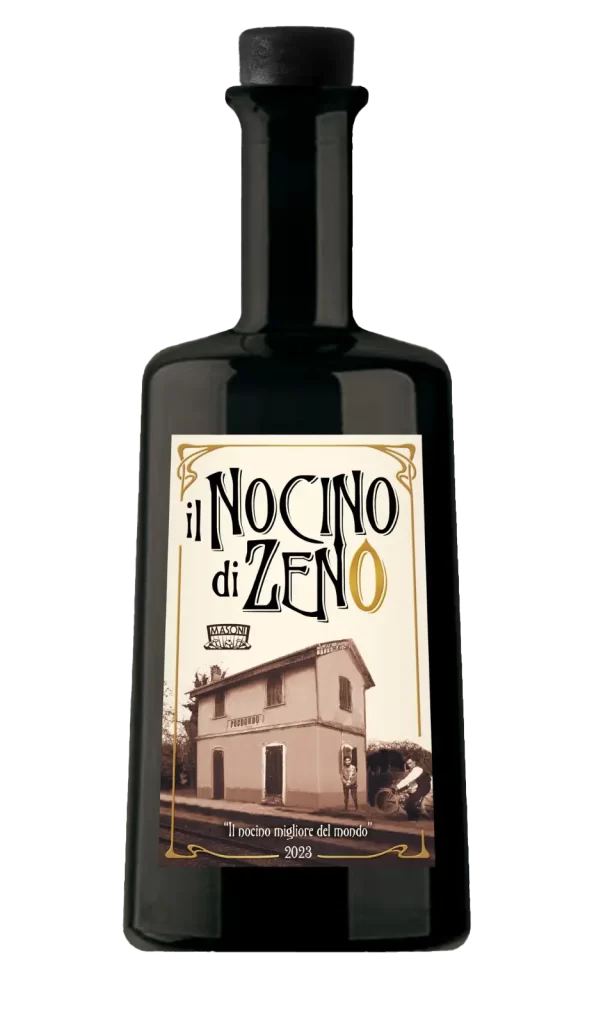Zeno's Walnut Liqueur
"The Best Walnut Liqueur in the World."

Start
In the 1920s, during the pioneering era of motorcycling, young Zeno would accompany... always to the Fosdondo station, his father Aderito, a skilled rider, when he set off for reach the race circuits. Zeno always kept a walnut in his pocket as a lucky charm. and when the train brought his father back, his heart would race, and if he saw from the window, his arm waving joyously, a golden trophy sparkling in the sun, he would run all happily to plant the walnut he had held tightly in his hand. When Aderito concluded his remarkable competitive career, Zeno used the fruit of those now grown trees, to produce a walnut liqueur and savor those moments again unforgettable: the result is an infusion from a magical recipe that still preserves more than a century ago the taste of those victories.

Fosdondo


Fosdondo was a locality of considerable significance even in Roman times, as evidenced by numerous discoveries of ancient ruins within its territory. When it was incorporated into the Matilda’s feud, a majestic parish church was built that overlooked endless stretches of walnut trees, demonstrating Fosdondo’s close relationship with that particular fruit. The cool, slightly acidic soil, rich in organic matter and with significant water supply, contributed to the growth of monumental plants. When in the late Middle Ages the production of homemade distillates began to take root in Fosdondo, the presence of walnuts gave rise to the tradition of walnut liqueur. Medieval physicians praised its virtues, and Arnaldo da Villanova wrote, “it prolongs a state of good health, dispels excess humors, revives the heart, and keeps one youthful.”
The Fosdondo station
The Fosdondo station was a place of railway reverence, much like the nearby oratory dedicated to the Madonna, which had a unique feature: its main facade faced the railway. When the small train (littorina) approached, the driver would slow down and come to a stop long enough for everyone, including the passengers, to bow and make the sign of the cross before continuing on their journey. The railcar always traveled straight ahead; each station had its own distinct scent and unique sound. People would board with one dialect and disembark with another. It was a slow but steady journey that allowed for the observation of the beautiful landscape of the Po Valley.
meanwhile, through the open windows, passengers were gently caressed by the unmistakable countryside air. The railcar, with its rounded and aerodynamic nose, always seemed right. Everyone stopped in its path, and as it glided along to the rhythmic sound of the rails, travelers felt wealthy. The Fosdondo station represented an open gateway to the future for the community, both for those arriving and those leaving with their one-way tickets and suitcases in hand. It was a cathedral to which millions of passengers had been devoted from the late 1800s to the mid-1900s. Then, one day, someone decided to turn it into a dead end. They closed its doors forever, but inside, the countless emotions born and passed through there are still very much alive, ready to depart with the narrative of an important piece of Italian history. Now, they travel while remaining stationary in front of the old fireplace that warmed the waiting room, and through the doors, only the scent of the walnuts planted nearby by Zeno enters.


Walnut liqueur.

Walnut liqueur was not just a simple walnut husk infusion; it was much more. It was the first liqueur of the Emilian tradition in which every family identified with its own specific secret recipe. In this competitive atmosphere, young Zeno conceived the idea of creating a new walnut liqueur that would surpass, just as his father had done in motorcycle races, the walnut liqueurs produced up to that point. And so, “The Best Walnut Liqueur in the World” was born.
Tasting a glass of Zeno’s walnut liqueur, the element of transgression emerges in the first moments because the context in which it was born opens up to the transcendent, in a metaphysical renaissance that creates the need to belong to that place: Fosdondo!
The competitions
The number of motorcycle races that were held in the 1920s was impressive. There wasn’t a celebration without a race; all it took were the start and finish banners, some bales of straw, permission from the Carabinieri, and the game was on. Aderito, Zeno’s father, raced with a G.D, which at the time was considered the pinnacle of technology, and thanks to its numerous sporting achievements, it was the most coveted motorcycle among both riders and the public.


Aderito Masoni
Aderito proudly made his contribution to the homeland by discontinuing his competitive racing activities.

Aderito returned, ready to face his life as a competition, always on the offensive.

Zeno Masoni
In 1955, Zeno traveled to the USA, and his long journey began right from the Fosdondo station. He managed to catch the last ride that train would ever make because when he returned from America, the railway was no longer there, thus marking the end of an extraordinary saga that began and ended in the same place.

To New York...
to bring the word to the New World, with a counterrevolutionary push rooted in a glorious past that served to convey significantly new content.
… from Fosdondo

